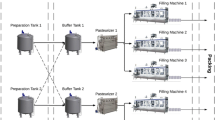Abstract
Wafer slicing in photovoltaic industry is mainly done using multi-wire saw machines. The selection of set of bricks (parallelepiped block of crystalline silicon) to be sawn together poses difficult production scheduling decisions. The objective is to maximize the utilization of the available cutting length to improve the process throughput. We address the problem presenting a mathematical formulation and an algorithm that aims to solve it in very short running times while delivering superior solutions. The algorithm employs a reactive greedy randomized adaptive search procedure with some enhancements. Computational experiments proved its effectiveness and efficiency to solve real-world based problems and randomly generated instances. Implementation of an on-line decision system based on this algorithm can help photovoltaic industry to reduce slicing costs making a contribution for its competitiveness against other sources of energy.
Similar content being viewed by others
References
EPIA European Photovoltaic Industry Association and Greenpeace (2005) Solar generation v. Technical report
Swanson RM (2006) A vision for crystalline silicon photovoltaics. Prog Photovolt: Research and Applications 14(5):443–453
Jester TL (2002) Crystalline silicon manufacturing progress. Prog Photovolt: Research and Applications 10(2):99–106
Zulehner W (2000) Historical overview of silicon crystal pulling development. Mater Sci Eng B 73(1–3):7–15
del Cañizo C, del Coso G, Sinke WC (2009) Crystalline silicon solar module technology: towards the 1 euro per watt-peak goal. Prog Photovolt: Research and Applications 17(3):199–209
Martello S, Toth P (1990) Knapsack problems: algorithms and computer implementations. Wiley, New York
Eilon S, Christofides N (1971) The loading problem. Manage Sci 17(5):259–268
Pisinger D (1999) An exact algorithm for large multiple knapsack problems. Eur J Oper Res 114(3):528–541
Fukunaga A (2009) A branch-and-bound algorithm for hard multiple knapsack problems. Ann Oper Res. doi:10.1007/s10479-009-0660-y
Caprara A, Kellerer H, Pferschy U (2003) A 3/4-approximation algorithm for multiple subset sum. J Heuristics 9(2):99–111
Martello S, Toth P (1981) Heuristic algorithms for the multiple knapsack problem. Computing 27(2):93–112
Khuri S, Bäck T, Heitkötter J (1994) The zero/one multiple knapsack problem and genetic algorithms. In: Proceedings of the 1994 ACM symposium on applied computing. ACM, Phoenix, Arizona, USA, pp 188–193
Raidl GR (1999) A weight-coded genetic algorithm for the multiple container packing problem. In: Proceedings of the 1999 ACM symposium on applied computing. ACM, San Antonio, Texas, USA, pp 291–296
Fukunaga AS (2008) A new grouping genetic algorithm for the multiple knapsack problem. In: IEEE congress on evolutionary computation, 2008. CEC 2008, IEEE world congress on computational intelligence, pp 2225–2232
Kellerer H, Pferschy U, Pisinger D (2004) Knapsack problems. Springer, Berlin
Feo TA, Resende MGC (1995) Greedy randomized adaptive search procedures. J Glob Optim 6(2):109–133
Binato S, Hery WJ, Loewenstern DM, Resende MGC (2000) A grasp for job shop scheduling. In: Essays and surveys on metaheuristics. Kluwer, Dordrecht, pp 59–79
Prais M, Ribeiro CC (2000) Reactive grasp: an application to a matrix decomposition problem in tdma traffic assignment. INFORMS J Comput 12(3):164–176
Adil GK, Ghosh JB (2005) Forming gt cells incrementally using grasp. Int J Adv Manuf Tech 26(11):1402–1408
Prabhaharanl G, Shahul Hamid Khan B, Rakesh L (2006) Implementation of grasp in flow shop scheduling. Int J Adv Manuf Tech 30(11):1126–1131
Resende M, Ribeiro C (2003) Greedy randomized adaptive search procedures. Kluwer, Dordrecht. pp 219–249
Almada-Lobo B, Oliveira JF, Carravilla MA (2008) Production planning and scheduling in the glass container industry: a vns approach. Int J Prod Econ 114(1):363–375
Glover F (1996) Tabu search and adaptive memory programing advances, applications and challenges. In: Interfaces in computer science and operations research. Kluwer, Dordrecht, pp 1–75
Author information
Authors and Affiliations
Corresponding author
Rights and permissions
About this article
Cite this article
Guimarães, L., Santos, R. & Almada-Lobo, B. Scheduling wafer slicing by multi-wire saw manufacturing in photovoltaic industry: a case study. Int J Adv Manuf Technol 53, 1129–1139 (2011). https://doi.org/10.1007/s00170-010-2906-x
Received:
Accepted:
Published:
Issue Date:
DOI: https://doi.org/10.1007/s00170-010-2906-x




